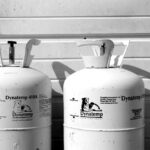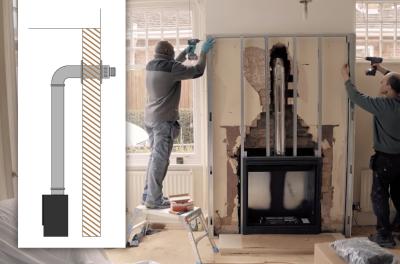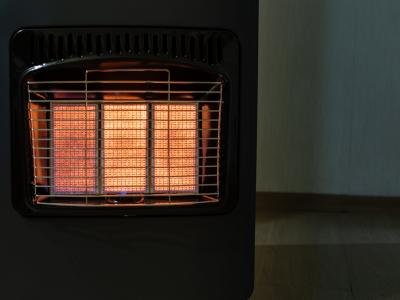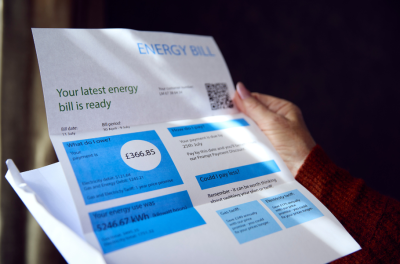We use cookies to improve your experience and our business. See our privacy/cookie policy or continue browsing to accept our use of cookies. View our cookie policy.
What You Need to Know About Maintaining & Servicing a Gas Fireplace
Whether you’ve got a new gas fireplace or one that’s been providing faithful service for year after year, it’s important that you not only get it serviced on a regular basis, but that you maintain and clean it too. Keep reading and the Direct Fireplaces team will tell you what you need to know about gas fireplace maintenance and servicing…
Why is gas servicing and maintenance important?
Do you really need to pay that much attention to the condition of your gas fireplace? The answer is a firm yes!
Not only is an annual service an absolute must from a safety perspective, but taking the time to regularly inspect, clean and generally maintain your gas fireplace will mean you spot any potential problems early and help you make your appliance last longer. Gas fireplace maintenance really can save you money; both in the short and long term!
Note - most manufacturers' warranties will be void unless you can provide proof of an annual service.
Servicing a gas fireplace: what you need to know
Let’s start off with what is arguably the most important point; the annual service of your gas fireplace.
This is an absolute must.
Whilst it may be tempting to forgo the expense, it really isn't worth the risk. Faults in gas fires are not always obvious and leaks of carbon monoxide can lead to poisoning and even death.
As such, you should have your gas fire inspected at least once a year by a Gas Safe Registered gas engineer.
The Gas Safe Register is the official register of gas businesses and engineers across the UK. By law all gas businesses and gas engineers must be on the register.
By using a Gas Safe Registered gas engineer you can be assured that they have demonstrated their competence through an organised route of training and assessment overseen by the Gas Safe Register.
What does a gas fire service involve?
During a gas fire service, the gas engineer will undertake a series of visual checks, inspections and tests. As per the Gas Safe Register website, these include:
- ‘A visual examination of the gas fire and its flue to ensure it’s suitably located and installed.
- Checking and cleaning various components of the appliance.
- Testing for leaks.
- Conducting a pressure test’.
Following these tests and checks, the gas engineer will then usually carry out what’s called a ‘gas fire safety check’.
What is a gas fire safety check?
Some gas engineers offer to carry out gas fire safety checks alone rather than full services.
Gas fire safety checks are like a gas fire service, but are a little less in depth. They will typically involve the gas engineer checking that the appliance is in good working condition and with no faults or defects.
These checks will typically involve; ensuring that the settings are working correctly, the burners within the fire are operating correctly, the fire is operating at the correct pressure, and that harmful gases are being safely vented through the flue.
Regardless of whether you have a full service with a safety check, or just a safety check alone, should the gas engineer identify any faults or safety issues with your gas fire, they are obliged to create a report (in accordance with the Gas Industry Unsafe Situations Procedure).
They should leave a copy of this report with you and it should detail any repairs that the engineer has made in order to rectify the identified faults.
How much does an annual gas fire service or gas fire safety check cost?
If you want the reassurance of a full gas fire service (with a safety check included), then you should expect to pay approximately £100 (updated for May 2023).
If you only want a gas fire safety check, then you should expect this to cost in the region of £85.
Please note that these prices may vary depending on your specific requirements.
As you can see there isn’t a huge difference in price between the two. Here at Direct Fireplaces we’d strongly recommend opting for the full service with a safety check included.
Gas fire services can save you money
Whether you go for a full service or a safety check alone, having these done can actually save you money in the long run.
Why?
Because having a Gas Safe Registered engineer inspect your fire will bring to light any issues or potential faults before they have a chance to become a bigger problem.
For example, a Gas Safe Registered engineer may spot a problem with the fire’s flue, which can be easily fixed. But, if left too long, could result in the entire appliance needing to be replaced.
So, it pays (literally) to have your gas fire inspected every year.
How to spot problems with your gas fire
Whilst an annual check will be enough to keep you and your family safe, it’s good to know the signs of any problems with your gas fire so that you can get them fixed straight away.
The warning signs to look for include:
- The smell of gas.
- Soot building up on the fire’s glass, logs or around the edges of the appliance.
- It’s a struggle to get your gas fire to ignite.
- Pops or other unusual sounds coming from your fire.
- You are experiencing physical symptoms like headaches, dizziness and nausea.
If you spot or experience any of these things, call a Gas Safe Registered gas engineer immediately.
Note - if you smell gas, this could be evidence of a leak which constitutes an emergency. Please follow the Gas Safe Register’s gas leak protocols which can be found here.
Maintaining and cleaning a gas fireplace: what you need to know
Aside from having your gas fire properly serviced on an annual basis, it's also important to pay attention to gas fireplace maintenance and clean your gas fire regularly.
As we mentioned earlier, taking the time to maintain and clean your gas fire can help make your appliance last longer and help you identify any issues before they have a chance to get worse.
Ensure your appliance is turned off and cool
This should go without saying, but before you decide to undertake any gas fireplace maintenance, you should make sure that it is turned off and completely cool.
If your fireplace has a pilot light, then you should make sure this is turned off and completely extinguished before you carry out any maintenance or cleaning of the appliance.
Wipe down the outside of your fire
The first thing to do is to give the outside of your gas fire a thorough wipe down. A damp cloth will normally suffice for this task as all you’re aiming to do is get rid of any dust or dirt that may have accumulated on the top surfaces of the appliance.
Clean the glass
If you have a gas fireplace with a glass front (as opposed to a fire with an open front), then one of the quickest yet high impact things you can do is to clean the glass.
Depending on the type of gas fire you have, this glass will either be fixed in place, or may be removable.
If it’s fixed in place, then simply use a standard glass cleaner, a microfibre cleaning cloth, and plenty of elbow grease to get it looking like new again. (If you’d rather not use chemical-based cleaning sprays, then a white vinegar and lemon juice solution will also do the job).
If your fire is designed to allow you to remove the glass panel, then do so and place it on a dust sheet or some old newspaper. Depending on what model fire you have, removing the glass panel may require the use of a screwdriver or allen key.
Tip - whilst you’re cleaning the glass, use the opportunity to closely inspect it and look for any cracks. This is important as cracks can pose a safety risk.
Cleaning the firebox and coal/log bed
If you have either an open fronted gas fire, or a gas fire with a removable glass panel, then the next step in cleaning and maintaining your fireplace is to address the firebox and coal/log bed.
Doing this is as simple as using a feather duster to wipe away any dust or other bits that may have accumulated in and around the opening of the fireplace.
Pay special attention to the artificial log or coal bed, as these tend to accumulate dust as they have many nooks and crannies.
Note - it’s worth paying close attention to the coal/log bed when you’re cleaning them. Over time these can become discoloured. Luckily, many gas fire manufacturers sell replacements.
Vacuum vents and openings
It’s likely that your gas fireplace has a number of small vents, slits or openings (normally located on the top and/or sides of the fireplace depending on the model.
If that’s the case with your gas fire, then we recommend gently passing a vacuum cleaner nozzle over these vents. This will capture any dust or cobwebs that may have built up just beneath and around the vents.
Check your chimney/flue
This is an especially important part of gas fireplace maintenance.
However, it’s a job that can be easier or harder depending on what type of fire and flue you have.
If you are using a gas fire with a traditional Class 1 or more modern Class 2 chimney or a pre-cast flue, then you’ll probably need to call on the services of a chimney sweep to inspect your chimney and flue - this is mainly because the chimney will likely be venting out the top of your roof and so an inspection will involve working at height.
If you have a gas fire with a balanced flue, then inspecting it should be straightforward. This is because a balanced flue will normally vent out of one of the side external walls of your home (usually at about waist height). If that’s the case with your fire, you simply need to check that the flue is clear of any potential blockages such as leaves, twigs, nests etc.
Check the batteries in your carbon monoxide detector
One of the final things you should do when maintaining and cleaning a gas fire is to check that your carbon monoxide detector is fully functioning (if you haven’t got a CO2 detector, we strongly recommend that you buy one).
Many modern carbon monoxide detectors now feature built-in, long-lasting lithium-ion batteries meaning that they will stay active for between five to seven years. Nevertheless, it’s always worth checking them to ensure they are still functioning.
Check and/or change the batteries in your fireplace remote
An increasing number of fireplaces now come with remote controls. So, whilst you’re cleaning and maintaining your fireplace, it’s a good opportunity to check that they’re still working and if not, change the batteries!
Know when to replace your gas fireplace
Gas fireplaces, like any other home appliance, do have a finite lifespan. Yes, gas fireplace maintenance, cleaning and servicing on a regular basis will certainly go a long way towards extending a gas fireplace's lifespan, but there will come a point at which it’ll make sense to upgrade.
One of the most important things to consider at present, given the ever increasing cost of energy, is that older gas fireplaces tend to be much less efficient than newer ones.
In fact, many manufacturers are now producing high efficiency gas fireplaces which are designed to produce heat in the most economical way. So, it can actually save you money in the long run to replace your old gas fire with a modern, high-efficiency version.
Is your gas fire due for servicing? Don't delay this important maintenance task. Our partners Direct Heating Services offer servicing and maintenance packages starting from just £100. Email [email protected] or call 0161 376 4181 to get your quote.
Shop gas fireplaces at Direct Fireplaces now
Read more fireplace advice and information on the Direct Fireplaces blog…
Tips for Cleaning Your Fireplace | What Qualifications Should a Fireplace Installer Have? | Fireplaces & Carbon Monoxide: What You Need to Know
[related_products is_auto_added="1"]admin
Latest posts by admin (see all)
- Electric Fireplace Inserts Buying Guide - March 27, 2023
- What Types of Flueless Fires Are There? - February 23, 2023
- What Are the Best Contemporary Gas Fires? - January 17, 2023








